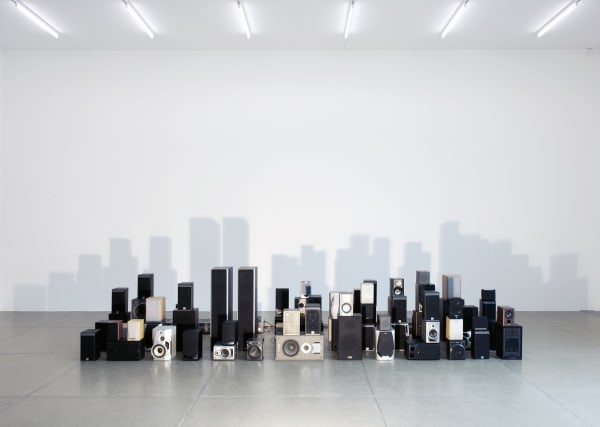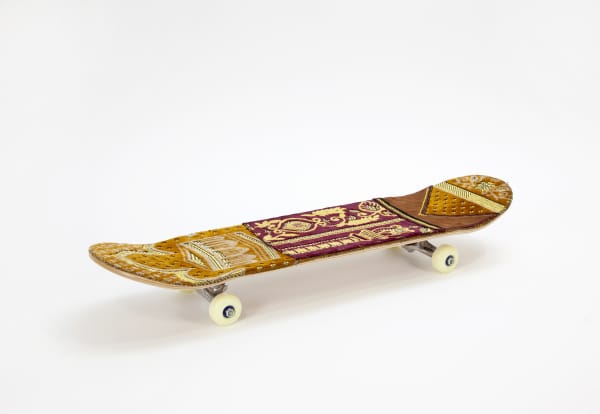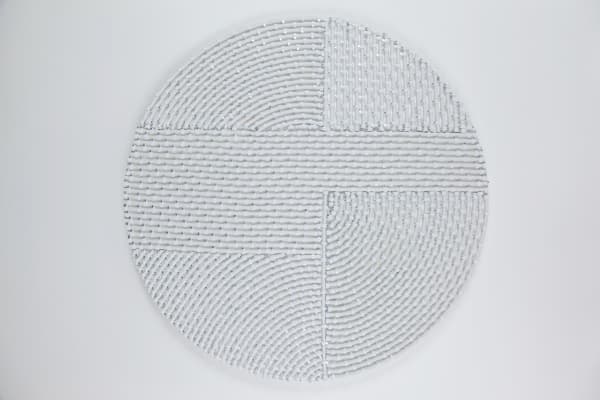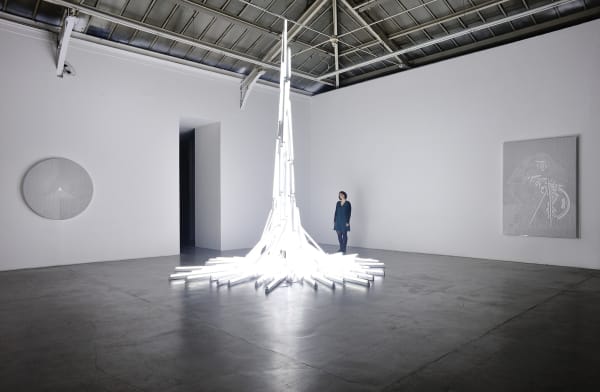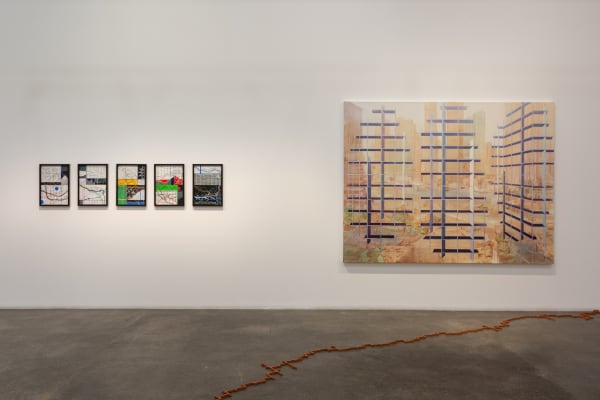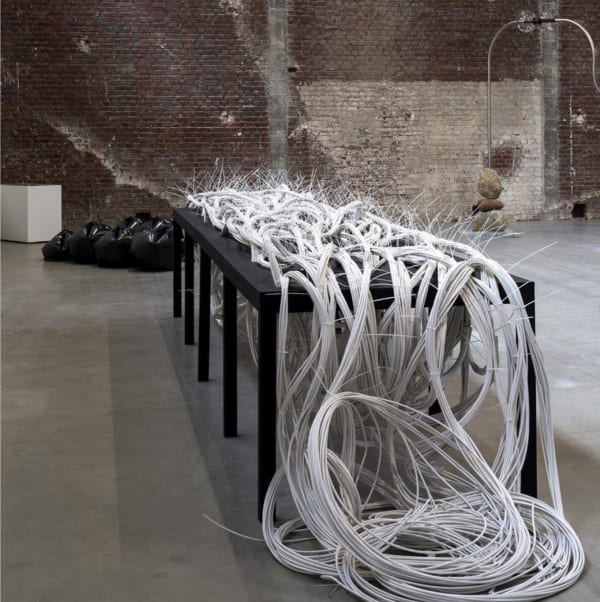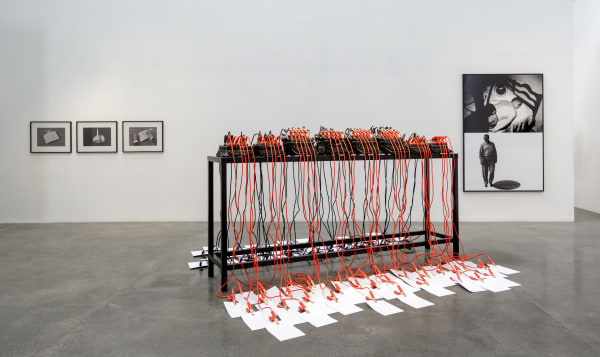Mounir Fatmi b. 1970
By using materials such as antenna cable, typewriters and VHS tapes, Mounir Fatmi elaborates an experimental archeology that questions the world and the role of the artist in a society in crisis. He twists its codes and precepts through the prism of a trinity comprising Architecture, Language and Machine. Thus, he questions the limits of memory, language and communication while reflecting upon these obsolescent materials and their uncertain future. Mounir Fatmi’s artistic research consists in a reflection upon the history of technology and its influence on popular culture. Consequently, one can also view his current works as future archives in the making. Though they represent key moments in our contemporary history, these technical materials also call into question the transmission of knowledge and the suggestive power of images and criticize the illusory mechanisms that bind us to technology and ideologies.
-
 Underneath, 2007
Underneath, 2007 -
 Save Manhattan 03, 2007
Save Manhattan 03, 2007 -
 Without History-Obstacles, 2007
Without History-Obstacles, 2007 -
 Bas-Relief/Al Jazeera, 2007
Bas-Relief/Al Jazeera, 2007 -
 Ghosting, 2009
Ghosting, 2009 -
 Modern Times, A History of the Machine, 2009
Modern Times, A History of the Machine, 2009 -
 Brainteaser For A Moderate Muslim, 2009
Brainteaser For A Moderate Muslim, 2009 -
 Mehr Licht, 2009-11
Mehr Licht, 2009-11 -
 Maximum Sensation 52, 2010
Maximum Sensation 52, 2010 -
 Forget, 2010
Forget, 2010 -
 Intersection 05, 2011
Intersection 05, 2011 -
 Circles 02, 2011
Circles 02, 2011 -
 CIrcles 05, 2011
CIrcles 05, 2011 -
 Intersection 09, 2011
Intersection 09, 2011 -
 Union Impossible, 2011
Union Impossible, 2011 -
 In the absence of evidence to the contrary, 2012
In the absence of evidence to the contrary, 2012 -
 The Blinding Light, 2013
The Blinding Light, 2013 -
 The Blackboard (Version 1), 2013
The Blackboard (Version 1), 2013 -
 History is Not Mine, 2013
History is Not Mine, 2013 -
 Deconstruction Structure N°1, 2015
Deconstruction Structure N°1, 2015 -
 Inside the Fire Circle, 2017
Inside the Fire Circle, 2017
Mounir Fatmi was born in Tangiers, Morocco, in 1970. When he was four, his family moved to Casablanca. At the age of 17, he traveled to Rome where he studied at the free school of nude drawing and engraving at the Academy of Arts, and then at the Casablanca art school, and finally at the Rijksakademie in Amsterdam.
He spent most of his childhood at the flea market of Casabarata, one of the poorest neighborhoods in Tangiers, where his mother sold children’s clothes. Such an environment produces vast amounts of waste and worn-out common use objects. The artist now considers this childhood to have been his first form of artistic education, and compares the flea market to a museum in ruin. This vision also serves as a metaphor and expresses the essential aspects of his work. Influenced by the idea of defunct media and the collapse of the industrial and consumerist society, he develops a conception of the status of the work of art located somewhere between Archive and Archeology.
Since 2000, Mounir Fatmi’s installations have been selected in several biennials, the 52nd and 57th Venice Biennales, the 8th Sharjah Biennale, the 5th and 7th Dakar Biennales, the 2nd Seville Biennale, the 5th Gwangju Biennale, the 10th Lyon Biennale, the 5th Auckland Triennial, the 10th and 11th Bamako Biennales, the 7th Shenzhen Architecture Biennale, the Setouchi Triennial and the Echigo-Tsumari Triennial in Japan.
Fatmi’s select institutional exhibitions include Mamco, Geneva, Migros Museum für Gegenwarskunst, Zürich, Switzerland; Picasso Museum, war and peace, Vallauris; FRAC Alsace, Sélestat; Contemporary Art Center Le Parvis; Fondazione Collegio San Caro, Modena; AK Bank Foundation, Istanbul; Museum Kunst Palast, Duesseldorf and MMP+,Marrakesh.
Fatmi's solo exhibitions include ones at the Migros Museum, Zurich; MAMCO, Geneva; Picasso Museum La Guerre et la Paix, Vallauris; AK Bank Foundation, Istanbul; Museum Kunst Palast, Düsseldorf and at the Gothenburg Konsthall.
He also participated in several group exhibitions including ones at the Centre Georges Pompidou, Paris. Brooklyn Museum, New York. Palais de Tokyo, Paris. MAXXI, Rome. Mori Art Museum, Tokyo. MMOMA, Moscow. Mathaf, Doha, Hayward Gallery and the Victoria & Albert Museum, London. Van Abbemuseum, Eindhoven and at Nasher Museum of Art, Durham.
He has participated in several group shows including Traditional Interrupted, Bedford Gallery, Walnut Creek, USA, 2019; Wasl-Beyond the Pen, King Abdulaziz Center for World Culture, Dhahran, Saudi Arabia, 2019; Revolution Generations, Mathaf Arab Museum of Modern Art, Dohs, Qatar, 2019; EXOTIC x MODERN: French Art Deco and Inspiration afar, Tokyo Metropolitan Teien Art Museum, Tokyo, Japan, 2018; Second Life Second Breath, Musee d' Art Contemporain Africain Al Maaden (MACAAL), Marrakech, Morocco, 2018; Beyond Borders, Foundation Boghossian - Villa Empain, Brussels, Belggium, 2018; Somewhere Behind the Eyes, Sammlung Philara, Dusseldorf, Germany, 2018; People Ger Ready, Nasher Museum of Art at Duke University, Durham, USA, 2018; Cut Up/Cut Out, Ellen Noel Art Museum, Odessa, USA, 2018; BRIC-a-Brac | The Jumble of Growth, Galleria Nazionale d' Arte Moderna e Contemoranea, Rome, Italia, 2018; 40 ans de collection et un film documentaire de 60 min, Fondation Fernet-Branca, Saint-Louis, France, 2018; Un œil ouvert sur le monde arabe, Institut du Monde Arabe, Paris, France, 2018; Motherland in Art,Museum of Contemporary Art in Krakow, Krakow, Poland, 2018; RESIST! The 1960s Protests, Photography and Visual Legacy, BOZAR, Palais des Beaux-Arts, Brussles, 2018; A Journey to Freedom, Tasmanian Museum & Art Gallary, 2018; Cut up/Cut out, Pensacola Museum of Art, University of West Florida, 2018. He has also participated in group shows at the Museum of Contemporary Art, Karakow; Centre Georges Pompidou, Paris; The Brooklyn Museum, New York; N.B.K., Berlin; MAXXI, Rome; Mori Art Museum, Tokyo; Museum on the Seam, Jerusalem; Moscow Museum of Modern Art, Moscow; Mathaf Arab Museum of Modern Art, Doha; the Hayward Gallery, London; the Art Gallery of Western Australia; the Victoria & Albert Museum, London and the Van Abbemuseum, Eindhoven. He has participated in biennials such as the 52nd and 54th Venice Biennial, the 8th biennial of Sharjah, the 5th and 7th Dakar Biennial, the 2nd Seville Biennial, the 5th Gwangju Biennial, the 10th Lyon Biennial, the 5th Auckland Triennial, Fotofest 2014, Houston and the 10th Bamako Encounters.
He has received several prizes, including the Uriöt prize, Amsterdam, the Grand Prix Léopold Sédar Senghor at the 7th Dakar Biennale in 2006, as well as the Cairo Biennale Prize in 2010.He was shortlisted for the Jameel Prize of the Victoria & Albert Museum, London in 2013.
His work is in several notable collections including: Sindika Dokolo Foundation, Luanda; Art Gallery of Western Australia, Perth; Queensland Art Gallery of Australia, Brisbane; AGO, Art Gallery of Ontario, Toronto; Fondation Louis Vuitton pour la création, Paris; Fonds National d'Art Contemporain, Paris; Fonds Régional d'Art Contemporain d'Alsace, Sélestat; Fonds Municipal d'Art Contemporain, Paris; MAMC Les Abattoirs, Toulouse; Cité nationale de l'histoire de l'immigration, Paris; Rosenblum & Friends, Paris; Foundation Frances, Senlis; FDAC L'Essonne & Château de Chamarande; Bibliothèque Municipale de Lyon; Museum Kunstpalast, Düsseldorf; Nadour, Krefeld; Written Art Foundation, Frankfurt; The Tiroche DeLeon Collection; Fondazione Cassa di risparmio di Modena, Modena; Darat al Funun, The Khalid Shoman Foundation, Amman; National Museum of Mali, Bamako; MMP+, The Marrakech Museum for Photography and Visual Arts, Marrakech; Bank Al-Maghrib, Casablanca; Wafabank Foundation, Casablanca; Museum of the ONA Foundation, Casablanca; MOCAK, Museum of Contemporary Art, Krakow; Qatar Foundation, Doha; Mathaf, Arab Museum of Modern Art, Doha; Jameel Foundation; King Abdulaziz Centre, Dhahran; Stedelijk Museum, Amsterdam; Rijksakademie Collection, Amsterdam; De Nederlandsche Bank N.V., Amsterdam; Miniature Museum Ria and Lex Daniels, The Hague; Kamel Lazaar Foundation, Tunis; Koč Foundation, Istanbul; The Farjam Collection, Dubai; Articulate Contemporary Art Fund, London; The Brooklyn Museum, New York and the Hessel Foundation for the Bard Museum, New York.
He lives and works between Paris and Tangier.
-

Mounir Fatmi Features at Biennale de Bamako
Bamako Enounters / Rencontres de Bamako 16 Nov 2024 - 15 Jan 2025 BiennialsMounir Fatmi's photographic triptych Calligraphy of Fire has been selected for this year's Bamako Biennale, where it will be showcased in its large 70 x 105 cm version. The 14th...Read more -

Monir Fatmi at Bienal Internacional de Poesía Experimental de Argentina - POSVERSO
18 Oct - 20 Dec 2024POSVERSO is a biennial focused on the multiple practices of intersemiotic poetry, which is generated by Hotel DaDA Base of Mail Art and Experimental Poetry, in the city of Junín,...Read more -
Mounir Fatmi at Colorado Springs Fine Arts Center at Colorado College
ALHAMDU - MUSLIM FUTURISM 13 Sep 2024 - 11 Jan 2025Curated by Yusuf Siddiquee ALHAMDU - MUSLIM FUTURISM at Colorado Springs Fine Arts Center will feature two works by Mounir Fatmi; Mixology (2010) and Modern Times (2010). ALHAMDU | MUSLIM...Read more -

Mounir Fatmi at the Pola Museum of Art in Japan
16 Dec 2023 - 19 May 2024 MuseumsMounir Fatmi participates in the group exhibition 'Modern Times in Paris 1925 - Art and Design in the Machine Age', curated by Yo Shoji at the Pola Museum of Art,...Read more -

Under Construction Part II
Group Exhibition 5 Jul - 22 Sep 2021 GalleryUnder Construction Part II expands on the notion of the uncompleted project, the work in progress, presenting a series of evolving, paradoxical, overlapping paradigms, where histories are re-evaluated, cultural artefacts...Read more -

Under Construction
Group Exhibition 31 May - 26 Jun 2021 GalleryUnder Construction , a group exhibition held in two parts, presents a series of incomplete, evolving, overlapping, paradoxical concepts - building structures, formulating symbols, manufacturing appearance, fabricating histories and reconstituting...Read more -

Our world is burning
Mounir Fatmi at Palais de Tokyo, Paris 21 Feb - 13 Sep 2020 MuseumsExhibition conceived in collaboration with the MATHAF. The exhibition Our World is Burning offers a fully political view of international contemporary creation seen from the Gulf, where wars and diplomatic...Read more -

Scripted Reality
10 Hanover Street | London W1S 1YQ 26 Jun - 3 Jul 2018 GalleryLawrie Shabibi is excited to announce “Scripted Reality ”, a group exhibition of six artists to be shown at 10 Hanover. This is Lawrie Shabibi’s first exhibition outside our gallery...Read more -

Inside the Fire Circle
Mounir Fatmi 8 Mar - 15 May 2017 GalleryLawrie Shabibi is pleased to present “Inside the Fire Circle” Mounir Fatmi’s first solo exhibition in Dubai. The exhibition expands on the artist’s interest in the circle, its form and...Read more -

'Flags' at the Boghossian Foundation
22 Jan 2023 MuseumsMounir Fatmi's The Lost Springs (2017) is currently on view at the Flags group exhibition at The Boghossian Foundation in Brussels, Belgium. Curated by Alfred Pacquement, Flags explores the question...Read more
-

Mounir Fatmi
180° Behind Me (2018), Göteborgs Konsthall, Sweeden June 20, 2018Göteborgs Konsthall is proud to present the first major Scandinavian solo exhibition with Moroccan-born artist Mounir Fatmi. Engaging in notions of the written word –...Read more -

Mounir Fatmi
Jameel Prize 3, V&A London January 11, 2018Morocco-born Mounir Fatmi lives and works between Paris and Tangier. He creates videos, installations, drawings, paintings and sculptures that directly address the current events of...Read more


